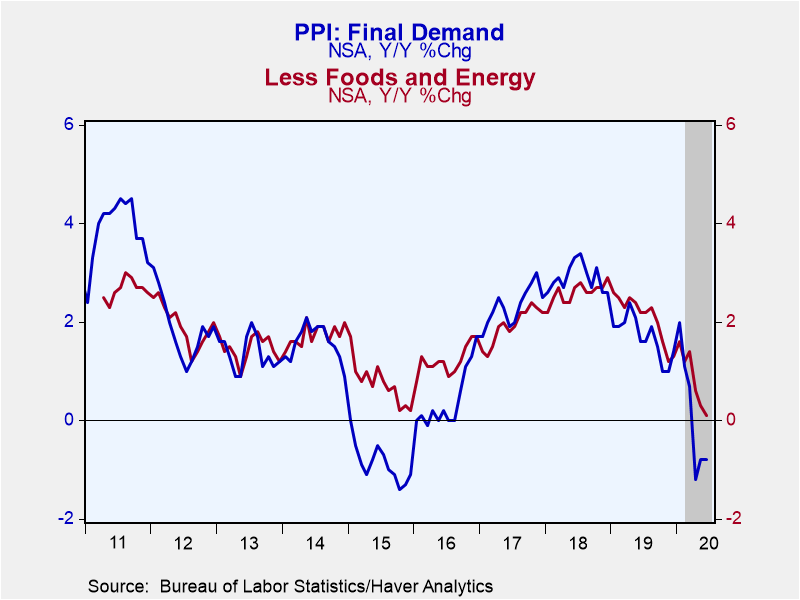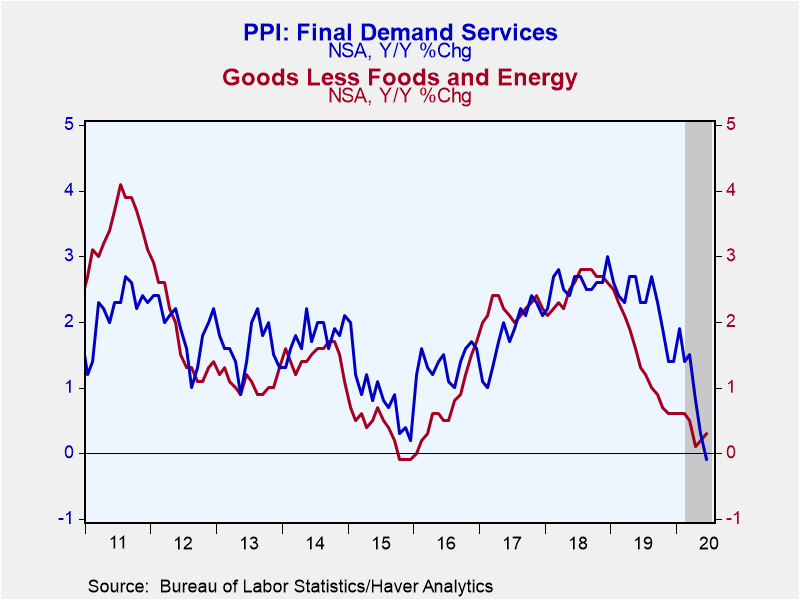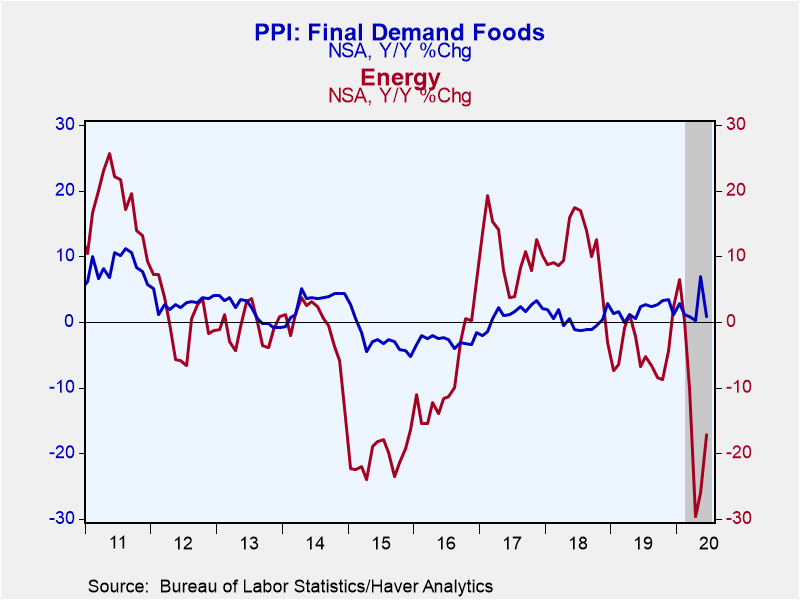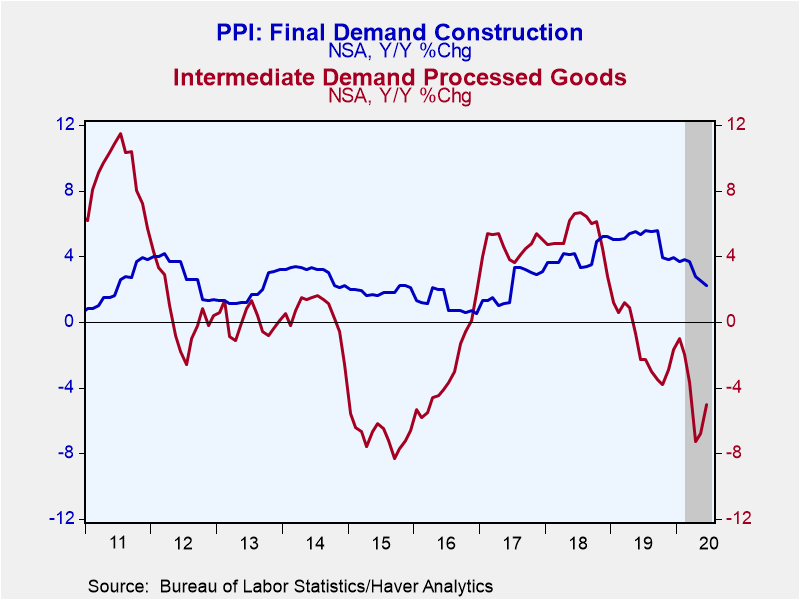 Global| Jul 10 2020
Global| Jul 10 2020U.S. Producer Prices Decline Unexpectedly in June; Food Prices Fall Sharply
by:Tom Moeller
|in:Economy in Brief
Summary
• Price index less food & energy eases as the coronavirus curbs demand. • Core goods prices inch higher. • Service price decline led by trade services. Pricing power remains weak in the industrial sector. The Producer Price Index for [...]
• Price index less food & energy eases as the coronavirus curbs demand.
• Core goods prices inch higher.
• Service price decline led by trade services.
Pricing power remains weak in the industrial sector. The Producer Price Index for final demand fell 0.2% (-0.8% y/y) during June following a 0.4% May increase. It was the fourth decline in five months. A 0.4% increase had been expected in the Action Economics Forecast Survey. Underlying pricing pressure remained weak. Producer prices excluding food & energy eased 0.3% (+0.1% y/y), the third consecutive monthly decline. A 0.1% rise had been expected. Another measure of underlying pricing power is the PPI excluding food, beverages and trade services. It improved 0.3% last month (-0.1% y/y) after edging 0.1% higher in May.
A 5.2% decline in food prices held back the change in the PPI overall, almost reversing a 6.0% rise in May. A 44.5% decline (+4.5% y/y) in beef & veal prices led the falloff as it reversed a 69.1% jump, and the price of pork fell 15.2% (-4.4% y/y). Egg prices also weakened 12.7% (NSA) but rose 14.7% y/y. Oilseed prices were off 1.1% (+3.9% y/y). These declines were offset by an 11.9% increase (NSA, -2.9% y/y) in vegetable prices and a 6.1% increase (NSA, 1.7% y/y) in the cost of fresh fruit & melons. Bakery product prices held steady (1.0% y/y).
A 7.7% strengthening in energy prices countered the decline last month. Gasoline prices increased 26.3% (-36.3% y/y) following a 43.9% May rise. The cost of home heating oil surged 53.3% (-44.2% y/y) and natural gas prices rose 0.4% (0.1% y/y). The cost of electric power was off 0.4% (-1.3% y/y), down for the fourth month in the last five.
Final demand goods prices less food & energy edged 0.1% higher last month after holding steady in May. Prices for finished consumer goods less food & energy were unchanged (1.1% y/y). Core nondurable goods prices also held steady (+1.5% y/y) following years of strength. Women's apparel prices declined 0.7% y/y but men's clothing costs rose 0.6% y/y. Durable consumer product prices improved 0.4% y/y while household appliance prices rose 1.1% y/y.
For businesses, private capital equipment prices rose 0.1% last month (1.0% y/y) and added to the prior month's 0.2% rise.
Services prices for final demand slipped 0.3% in June, down for the fourth month in the last five. Trade services prices fell 1.8%, as the cost of trade of finished goods weakened 1.9% (+0.8% y/y). A 0.9% rise (-4.7% y/y) in transportation & warehousing services prices offset the decline. Excluding these costs, trade services prices improved 0.3% (0.1% y/y).
The cost of construction weakened 0.3% last month following a 0.1% easing.
Intermediate product prices increased 0.9% (-5.0% y/y), following a 0.1% uptick.
The PPI data can be found in Haver's USECON database. Further detail can be found in PPI and PPIR. The expectations figures are available in the AS1REPNA database.
House Price Booms, Then and Now from the Federal Reserve Bank of Philadelphia is available here.
| Producer Price Index (SA, %) | Jun | May | Apr | Jun Y/Y | 2019 | 2018 | 2017 |
|---|---|---|---|---|---|---|---|
| Final Demand | -0.2 | 0.4 | -1.3 | -0.8 | 1.7 | 2.9 | 2.3 |
| Excluding Food & Energy | -0.3 | -0.1 | -0.3 | 0.1 | 2.1 | 2.6 | 1.9 |
| Excluding Food, Energy & Trade Services | 0.3 | 0.1 | -0.9 | -0.1 | 2.0 | 2.9 | 2.1 |
| Goods | 0.2 | 1.6 | -3.3 | -2.6 | 0.4 | 3.4 | 3.4 |
| Foods | -5.2 | 6.0 | -0.5 | 0.8 | 1.8 | 0.2 | 1.2 |
| Energy | 7.7 | 4.5 | -19.0 | -17.1 | -4.4 | 10.1 | 10.6 |
| Goods Excluding Food & Energy | 0.1 | 0.0 | -0.4 | 0.3 | 1.4 | 2.5 | 2.2 |
| Services | -0.3 | -0.2 | -0.2 | -0.1 | 2.2 | 2.6 | 1.8 |
| Trade Services | -1.8 | -0.8 | 1.6 | 0.6 | 2.5 | 1.8 | 1.5 |
| Construction | -0.3 | -0.1 | 0.5 | 2.2 | 4.9 | 4.1 | 2.2 |
| Intermediate Demand - Processed Goods | 0.9 | 0.1 | -3.7 | -5.0 | -1.4 | 5.4 | 4.7 |
Tom Moeller
AuthorMore in Author Profile »Prior to joining Haver Analytics in 2000, Mr. Moeller worked as the Economist at Chancellor Capital Management from 1985 to 1999. There, he developed comprehensive economic forecasts and interpreted economic data for equity and fixed income portfolio managers. Also at Chancellor, Mr. Moeller worked as an equity analyst and was responsible for researching and rating companies in the economically sensitive automobile and housing industries for investment in Chancellor’s equity portfolio. Prior to joining Chancellor, Mr. Moeller was an Economist at Citibank from 1979 to 1984. He also analyzed pricing behavior in the metals industry for the Council on Wage and Price Stability in Washington, D.C. In 1999, Mr. Moeller received the award for most accurate forecast from the Forecasters' Club of New York. From 1990 to 1992 he was President of the New York Association for Business Economists. Mr. Moeller earned an M.B.A. in Finance from Fordham University, where he graduated in 1987. He holds a Bachelor of Arts in Economics from George Washington University.










